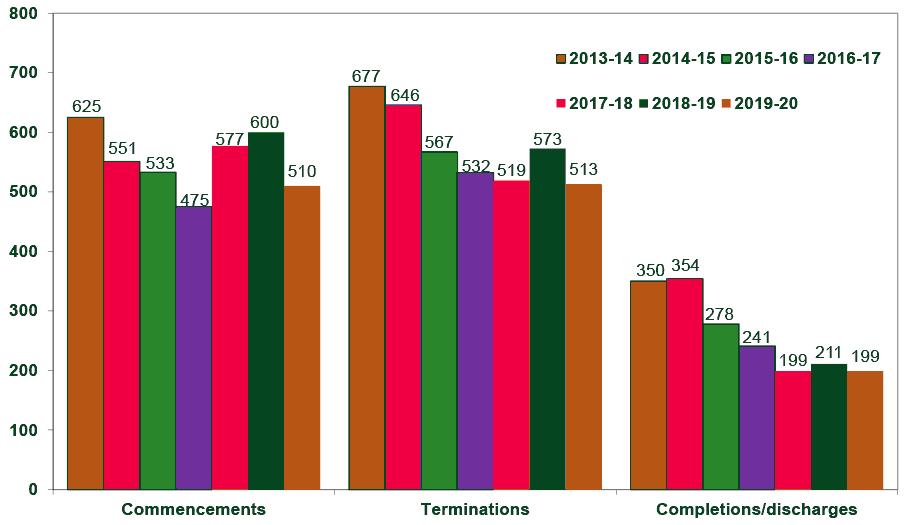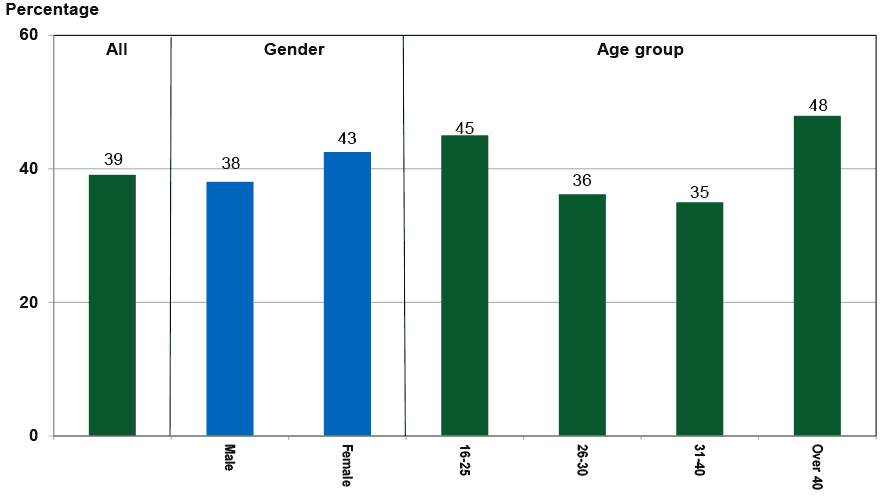Criminal justice social work statistics: 2019 to 2020
National-level information, as well as some local authority breakdowns, on criminal justice social work activity in Scotland. Also includes data on justice social work services and social work orders, as well as characteristics of the individuals involved.
5.3 Drug treatment and testing orders
Characteristics
5.3.1 The drug treatment and testing order (DTTO) is available to courts (excluding justice of the peace courts) as a high tariff disposal for people with substance-related offending who might otherwise get a custodial sentence. In addition, the less intensive DTTO II is available to courts in City of Edinburgh, East Lothian, Midlothian and Highland, and accounted for around 15 per cent of the DTTOs in these areas in 2019-20 (see §B.7).
5.3.2 The total number of DTTOs imposed fell each year between 2013-14 and 2016-17 to a low of 480, before rising in each of the next two years. Numbers fell again in 2019-20, by 15 per cent, to 510, the second lowest level in the last seven years (Tables 2 & 25 and Chart 8).

5.3.3 In 2019-20, there were 1.3 DTTOs imposed per 10,000 population (Table 3). This was highest for residents of City of Edinburgh (3.4), West Dunbartonshire (2.1) and Inverclyde (2.0). More information by local authority area can be found in the additional datasets which accompany this publication.
5.3.4 Over the last five years, people aged 31 to 40 have been the most likely to receive a DTTO (3 per 10,000 population in 2019-20). It has consistently been those aged 25 and under and those aged over 40 who have been the least likely (0.6 and 0.7, respectively, per 10,000 population in 2019-20).
5.3.5 The proportion of orders issued to males has been around 80 per cent over the last five years (Table 25). A very high proportion (generally around 90 per cent) of those receiving a DTTO are unemployed or economically inactive.
5.3.6 The average length of a DTTO has been between 17 and 18 months in each of the last five years (Table 25).
5.3.7 There were 590 DTTOs in force on 31 March 2020, the same as one year earlier (Table 2).
Timescales for implementation
5.3.8 The proportion of DTTOs which had first direct contact within one working day of the order being imposed rose to 69 per cent in 2019-20 (Table 26). The small number of orders involved mean there are inevitable year on year fluctuations for this proportion.
5.3.9 The proportion of orders where the first case management meeting took place within five working days also rose in 2019-20, to 82 per cent, which was around the levels in years 2015-16 to 2017-18 (Table 26). In around 10 per cent of cases in 2019-20, it took longer than ten working days for the first meeting to take place. Again, proportions fluctuate from year to year due to the small number of orders involved.
5.3.10 The reasons provided for not meeting these timescales in 2019-20 suggest that people receiving DTTOs have difficulty complying, as not attending meetings without an excuse is very prevalent. This was particularly the case for case management meetings. In 64 per cent of cases where the meeting did not occur within five working days, this was down to either the person not turning up or another client-related reason (Table 27).
Terminations
5.3.11 The percentage of orders successfully completed tends to be lower for DTTOs than for other social work orders, due to the complex needs of those involved and the intensity of the supervision involved in a DTTO.
5.3.12 The completion rate for DTTOs terminated fell each year between 2014-15 to 2018-19, from the historic high of 55 per cent in 2014-15 to 37 per cent in 2018-19 (Table 2). In the same period, the proportion of orders revoked due to review increased substantially from 16 per cent in 2014-15 to 35 per cent in 2018-19 (Table 28). While this has likely been a contributory factor in the fall in the completion rate over that period, orders can be revoked due to review for a number of different reasons, not all of which necessarily represent an unsuccessful outcome. In 2019-20, the successful completion rate rose slightly, to 39 per cent while 33 per cent were revoked due to review.
5.3.13 Eighteen per cent of orders in 2019-20 were revoked due to breach, around the same proportion as in previous years (Table 28). A custodial sentence was imposed in 31 per cent of revoked cases in 2019-20 (Table 29).
5.3.14 Seventy-five per cent of orders were terminated without breach applications (Table 30). The vast majority (92 per cent) of the breach applications were lodged with the court within five working days of the decision being made to make an application (see the additional datasets which accompany this publication).
5.3.15 People aged over 40 were still the most likely to successfully complete their order in 2019-20, with just under half doing so (Chart 9). The main reason for the rise in the overall success rate in 2019-20 was the increased proportion for 16 to 25 year olds, up from 30 per cent in 2018-19 to 45 per cent in 2019-20.

Notes: Age at imposition of order.
Longitudinal analysis
5.3.16 Table 31 shows results from a longitudinal analysis of the DTTO data. All bar a very small number of the orders imposed up to the end of March 2018 have now finished and this analysis mainly looks at completion rates by various factors for the cohorts of orders commenced in those years. For each of the years 2014-15 to 2017-18, while most orders were for over a year and up to 18 months in length, the completion rate was highest for orders of up to a year and lowest for those of over 18 months.
5.3.17 For each year apart from 2015-16, the success rate was substantially higher for DTTO IIs than for full DTTOs.
5.3.18 Unsurprisingly, whether there are breach application(s) during the course of an order is a major indicator of whether the order is likely to be successfully completed. Almost half of orders which started in 2017-18 and which had no breach applications, were successfully completed. This compared with only 8 per cent of orders where there was at least one breach application.
Contact
Email: Justice_Analysts@gov.scot
There is a problem
Thanks for your feedback